
Tons of Rock Lobster Beached on South Africa’s West Coast
Tons of West Coast rock lobster have beached themselves along South Africa’s west coast, particularly around Elands Bay and Doring Bay. The reason is harmful algal blooms… known as HABs. Save Our Seas Foundation Shark Education Centre explained the HABs occur when colonies of algae (which are simple plants that live in the sea and […]

Tons of West Coast rock lobster have beached themselves along South Africa’s west coast, particularly around Elands Bay and Doring Bay. The reason is harmful algal blooms… known as HABs.
Save Our Seas Foundation Shark Education Centre explained the HABs occur when colonies of algae (which are simple plants that live in the sea and freshwater) “grow out of control while producing toxic or harmful effects on people, fish, shellfish, marine mammals, and birds.”
It is rare, but humans can fall ill because of HABs and the effect cab be debilitating or even lead to death. Commonly known as ‘red tides’, scientists prefer the term ‘harmful algal bloom’ (HABs).
Not all algal blooms are harmful. Save Our Seas says: “Most blooms are beneficial because the tiny plants are food for animals in the ocean. In fact, they are the primary source of energy that fuels the ocean food web. ?”
The problem with ‘red tides’ is that all oxygen in the water column disintegrates. “Nothing escapes,” says Save Our Seas. “Deceased sharks, West coast rock lobster, hagfish and other species were photographed along the beach (on Tuesday). ???”
Yesterday, 1 March 2022, tons of West coast rock lobster beached themselves along the west coast around Elandsbaai and Doringbaai.
The reason? Harmful algal blooms (HABs) 🦠
Images by Sea Search pic.twitter.com/GoEQkTXsO5
— Save Our Seas Foundation Shark Education Centre (@sharkcentre) March 2, 2022
